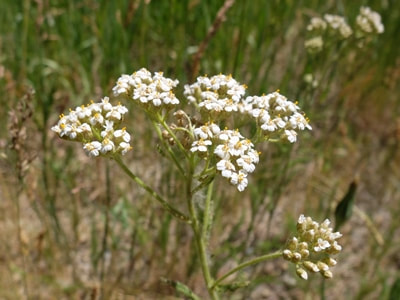|
Found in dry meadows and woods
Seen blooming in August near Hwy 554 in Abiquiu Yarrow grows one to two feet tall with feathery, fern-like leaves which have a strong, distinctive, not unpleasant smell. Small flowers grow in flat-topped clusters, most commonly white, less commonly pink. It is a popular cultivar and can be yellow, red and orange. The dried flowers are long-lasting and are often gathered for floral arrangements. Yarrow spreads from stout roots producing large patches of the fern-like leaves without flowers. It blooms all summer. The scientific name comes from the Greek character Achilles who is believed to have discovered the medicinal uses of this plant for healing his soldier’s wounds in the battle of Troy. Traditionally, Native Americans considered it a "life medicine" and used the plant as an analgesic and head cold remedy, for healing cuts and abrasions, relief from earaches, toothaches and throat infections, as well as for an eyewash. Source. If you are trying to identify a different flower then you can check what other flowers bloom this month. If you cannot identify a flower from the website, send a photo and where you took it to [email protected]. Read online for tips.
0 Comments
Leave a Reply. |
AuthorI am Marilyn Phillips, a native of England, whose love of nature and the outdoors from childhood brought me by a circuitous route to Crested Butte, Colorado in 1993 and 16 years later to northern New Mexico. My exploration of the many trails in these areas, my interest in wildflowers and photography, and career in computer system design came together in this creation. If you have any corrections, comments or questions, please contact me by email. Archives
September 2025
Categoriescopyright © 2020
|



 RSS Feed
RSS Feed